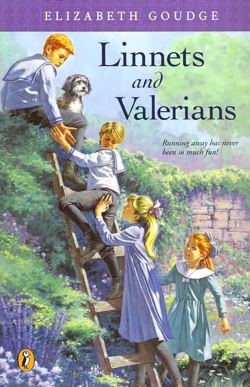At first glance, Linnets and Valerians, by Elizabeth Goudge, doesn’t look like children’s fantasy at all: No one goes to a school for wizards, or meets an elf, or a fairy; no one travels to another dimension, or to another time; there are no talking animals, no invisibility cloaks, no magic mirrors or poisoned apples. And not one character flies through the air on a broomstick, or on anything else: everyone’s feet are firmly planted on the good rich English earth.
And yet, in some ways, none of that is true, and many of those things DO happen. Because Linnets and Valerians is a book of both the purest naturalism and the purest magic. There are guardian bees and a shapeshifting cat and a book of evil spells, and at least three people are bewitched. There is one character who may be an elf, and another who is almost certainly a very nasty witch. There is a mirror that on one occasion seems to reflect something, or someone, from the past. There is a statue that may or may not occasionally come to life. There are corridors, and woodland paths, that lead different ways at different times. There is evil, and there is good, and both those things have demonstrable power.
The plot is like a delightful mashup of E. Nesbit and Frances Hodgson Burnett: the four Linnet children run away from their prim-and-proper grandmother and, almost by accident, end up with their curmudgeonly but secretly doting Uncle Ambrose, a curate and retired schoolmaster. The children ramble freely in the nearby countryside and village where they meet a bevy of characters: Lady Alicia Valerian, a recluse who, grieving for the long-ago loss of her family, never leaves her manor; Daft Davie, a mute hermit who lives and paints in a cave on the mountainside; and Emma Cobley, who owns the village shop and whose sweet candy-selling surface disguises sour intent. There is also, importantly, Uncle Ambrose’s servant, Ezra, who sings and dances in the moonlight and talks to the household bees, which he insists need to be told about any new residents or other important events. Through curiosity, friendliness, and sheerest bumbling, the children uncover long-held village secrets, and enable generations-old wrongs to be put right, and in the end everyone lives happily ever after.
The real-life magic of the English countryside is part of why the book resists easy categorization, why it’s a toss-up to describe it as a book that feels naturalistic although it’s all about magic, or one that feels magical while being firmly grounded in the natural world. The beauty of the landscape—the flowers, the woods, the hillside, the tor—literally enchants the children, who’ve grown up in India and don’t know anything first-hand about England. So the magic seems natural, and the nature seems magical, and it all gets mixed up together in their experience of the place and their new life.
The natural and supernatural are intertwined for the author, too. In her afterward she describes talking with people in a Dartmoor village much like the one described in the book, and the stories she heard of woods appearing out of nowhere one evening and never again, and of people seeing elves on the stairs, and of witchcraft black and white.
I read Linnets and Valerians as a child, and remembered it as one of those books—like The Secret Garden—that plays with the tropes of fantasy, and with the reader’s desire to believe in magic, without actually being fantasy. I started rereading a few weeks ago, armed with sticky notes, and a plan to mark each point where something magical, or something that could be interpreted as magical, was mentioned. I figured I could review the marked places when I was done, and see if the balance tipped towards fantasy or realism. But when I finished, my copy was bristling with sticky notes, too many to count: the whole book is shot through with magic.
It’s all, to use Jo Walton’s lovely phrase in Among Others, deniable magic: nothing happens that couldn’t be explained naturalistically. The shape-shifting cat could just be frightened children imagining things. The bees leading them into discovery or out of danger could be…bees, flying around. The book of magic spells could be mere ill-wishing. What Nan, the oldest child, sees in the sewing room might simply be an odd reflection in an old and wavy mirror. The most frightening scene—where the two boys are trapped in a beech tree, and Emma Cobley and her confederates plot to counter the protection of the beech with their own wicked power—could just be grownup bullies trying to scare kids.
But there are other explanations, that Ezra believes wholeheartedly, and the children come to believe, and even Uncle Ambrose, who explains at one point that as a curate he is not permitted to believe in ancient gods or supernatural powers, shows signs of accepting as real. Emma Cobley certainly does believe she’s casting spells, with intent to do harm, and harm is done. And Ezra and the children set out to undo—and, it’s not too much of a spoiler to say, succeed in undoing—that harm, on the same terms.
So the question hangs in the air: if everyone believes it, and it has the desired effects, is it real?
The answer, for the characters and the author, for the bees and the woods and the statue in the garden, is a resounding “yes.”
Linnets and Valerians is, alas, out of print. But it’s available in libraries and at used bookstores, and it’s wonderful to read on a gorgeous summer day, or even a rainy one.
Elisabeth Kushner is a writer and librarian in Vancouver.










